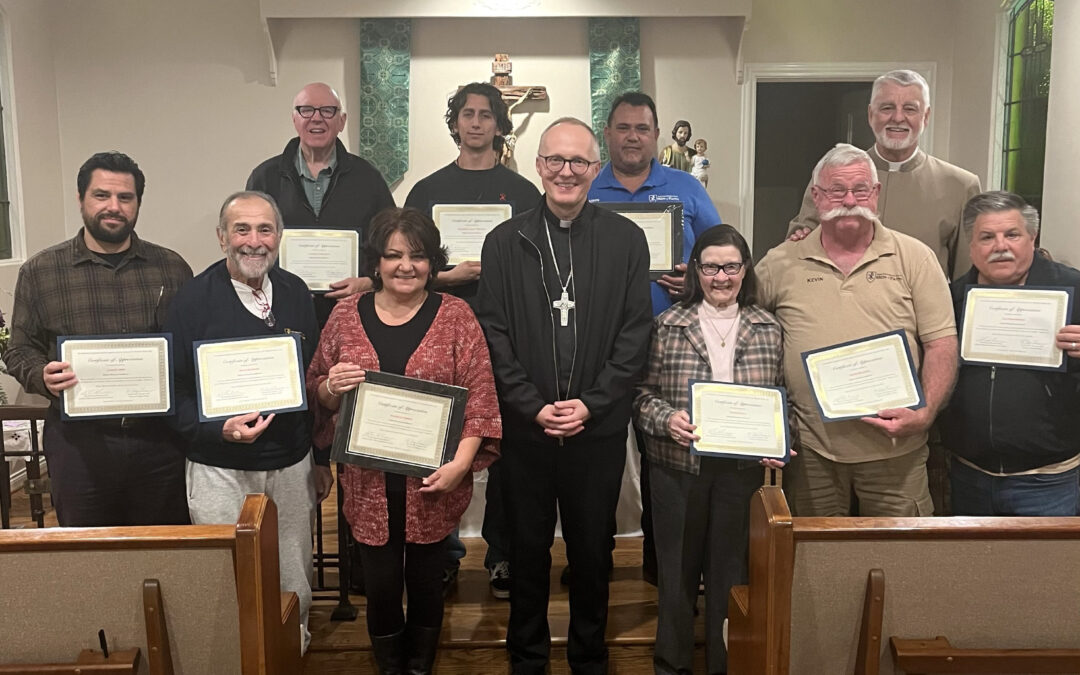
Dec 5, 2024 | News
“For just as the body is one and has many members, so it is with Christ…. Now you are the body of Christ and individually members of it. God has appointed in the church first apostles, second prophets, third teachers; then deeds of power, then gifts of healing, forms of assistance, forms of leadership, various kinds of tongues.” 1 Corinthians 12:12, 27-28.
Fr. Eusebe Menard, OFM, founder of the Society of the Missionaries of the Holy Apostles and founder of the seminary that bears its name, gave equal status to Mr. Hector Durand as the “co-founder” of the Society. Why was that? Mr. Durand was a faithful Catholic who happened to be a successful Contractor in Montreal Canada — and he contributed half his fortune to the building of seminaries. Together Fr. Menard and Mr. Durand modeled the crucial MSA charism of “partnership” between laity and the ministerial priesthood. In testimony of this, on the back of the official MSA chasuble, two hands are featured. The first is the priest’s hand that holds the earth’s globe. The second is the layman’s hand which supports the priest’s hand in ministry. In practical terms, the parts of the body of Christ work together to accomplish the mission of evangelizing and ministering to the world, together. Without Mr. Durand, Fr. Menard could not have done what he did. And thus, the Holy Spirit connected them together in order to do an extraordinary thing.
“St. Michael’s Retreat House,” in Oxnard, CA is an apostolate that I am privileged to serve, and which depends upon the MSA charism of clergy laity partnership. The various retreats and days of reflection offered at St. Michael’s would not be possible except for the generous time and financial assistance of a group called the “Men of Faith.” On every other Tuesday evening about 12-15 men offer prayers, a potluck, and a program. The men of faith have enthusiastically embraced St. Michael’s House as their “apostolate of service,” and they fund a parttime secretary to help their “tech-challenged” Director (yours truly) to administer the place.
Word of this reached the ears of Bishop Slawomir Szkredka, auxiliary for the Santa Barbara Pastoral Region who took the place of Bishop Robert Barron, who got St. Michael’s House off the ground and gave it its name.
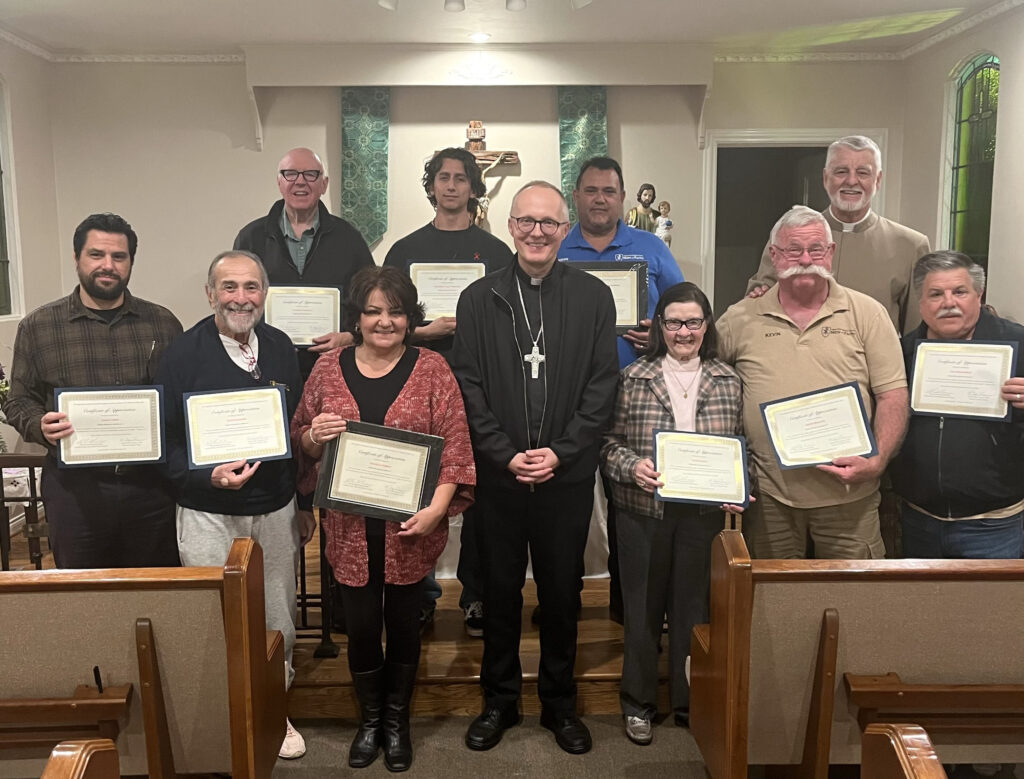
The “A Team” (Appreciation!) — from left to right — Juan Flores, David Sanchez, Charles Teachout, Michelle Kimble (Tuesday retreats), Lalo Miranda, Bishop Slawomir Szkredka, John Kimble, Vivian Cahill (retreat breakfasts) Kevin Williams, Fr. Skip Thompson, Joe Domitrovich. Missing in action for some good reason: Andy Stay, Torch Rivera, George Baldonado.
Bishop Slawomir came to our humble house to appreciate the Men of Faith at a dinner and presented each, including 2 “women of faith,” who regularly pull in the harness with House Director, Fr. Skip. The bishop signed a dozen certifications and presented them to each person.
It was a rare and very well-received moment for the bishop to take the time and recognize our special laypersons. Our contract to minister St. Michael’s house continues with his support and that of Provincial Animator (and HACS Chancellor) Martin Rooney and Santa Clara Church Pastor John Love. The MSA charism of clergy-lay partnership has brought us far — and the partnership will keep us growing as we minister on crucial issues affecting the faithful.
As we write this article, we are in the 34th week of Ordinary Time. But as I have said on numerous occasions, nothing is ordinary about the times the Church finds herself in now. We are no longer an “age of change,” (though things are changing rapidly). Rather we are in a “changing of the ages,” which requires the Church to reset her compass to follow a missionary course — and find a “few good men” to lead the Church and take her on the “offensive” once again.

Dec 5, 2024 | News
It was a celebratory night at the TPC River Highlands on Saturday, October 26, when alumni and friends of Holy Apostles College and Seminary gathered for a special evening to benefit the Holy Apostles Seminary Scholarship Fund.
Proceeds from the event will provide important funding to support vocations to the priesthood.
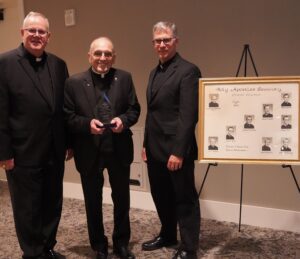
(l to r) Fr. Rooney, Fr. Ray Introvigne, and Fr. Peter Kucer
During the evening, President-Rector Fr. Peter Kucer presented the Holy Apostles Leadership Award to Fr. Ray Introvigne for his many years of service to the Catholic Church. Fr. Ray, who grew up in Stafford Springs, Connecticut, celebrated his 60th year as a priest this past May and graduated in the first class of Holy Apostles in 1960. He was appointed in 1977 to be the full-time director of Charismatic Renewal in the Norwich Diocese and continues with the Spiritual Renewal program to this day.
In his acceptance speech, Fr. Ray explained that he had not planned on the priesthood, and if not for Holy Apostles it may not have happened. He recalled that, before World War II, if a boy did not go to both Catholic grammar school and high school, they could not become a priest.
However, with the help of his pastor — and the Holy Spirit — Fr. Ray went to Boston to catch up on his Latin, French, English, and religious studies. Upon his return to Connecticut, Fr. Eusebe Menard, M.S.A. called and asked Fr. Ray to come and help him open the new Holy Apostles Seminary to which Fr. Ray agreed. As he said, “Holy Apostles is a gift of the Holy Spirit.”
Holy Apostles was the first seminary in the country to accept men with delayed vocations. As a result, many graduates of Holy Apostles are priests in dioceses across the country and in various religious orders both nationally and internationally.
Another guest speaker of the evening was recent graduate, Fr. Daniel Valente, M.S.A., who received his Master of Divinity degree from Holy Apostles in December 2023 and his Master of Arts in Sacred Scripture in May 2024.
Fr. Dan is now the Parochial Vicar at the Cathedral of Saint Joseph in Hartford, CT. He spoke to the guests about the support he received at Holy Apostles, and how important that was to his success in becoming a priest. Each day he tries to share the values he learned at Holy Apostles with his parishioners, centered in the Eucharist and the word of God.
Fr. Valente asked all to support the men at Holy Apostles studying for the priesthood, through prayers, time, and resources. As Fr. Valente said, “forming healthy, balanced priests who can

Cristi Shaw, Danielle Cutting, and Sr. Renee Marek, FSE.
meet the needs of the Church today is all our business. It costs money, it takes time, and it takes love. Love for God. Love for our Church. And for every single person’s respective vocation.”
The evening was an opportunity to mingle, enjoy delicious cuisine and listen to uplifting music from the Hosmer Mountain Boys.
We are very thankful for all who supported this important event. If you would like to make a gift to assist the seminary, you can do so at Make a Donation.

Nov 26, 2024 | News
FOR IMMEDIATE RELEASE
Monday, November 25, 2024
Holy Apostles Partners with Encounter School of Ministry to Advance Evangelical Mission
Dear Holy Apostles Community,
With great joy, I announce a new partnership between Holy Apostles College & Seminary and the Encounter School of Ministry. Through this collaboration, we will accept graduate and undergraduate transfer credits from Encounter, further advancing our shared mission of forming faithful disciples and leaders for the New Evangelization.
We are especially honored to work alongside Encounter’s Founder and President, Fr. Mathias Thelen, whose vision has guided Encounter’s transformative impact, and Executive Director Patrick Reis (MA Philosophy, ’14), a proud Holy Apostles alumnus. Their leadership has inspired countless students to embrace their faith with zeal while pursuing intellectual and spiritual formation.
This partnership underscores our mutual commitment to academic excellence and spiritual growth. Encounter students will now have accredited degree pathways to deepen their theological and philosophical education, equipping them to boldly proclaim the Gospel in today’s world.
May this collaboration bear abundant fruit for the Church and inspire a new generation of evangelists dedicated to Christ’s mission.
In Christ,
Rev. Peter Kucer, MSA
President Rector
Holy Apostles College & Seminary
Holy Apostles College and Seminary www.holyapostles.edu is a NECHE and ATS accredited college with a mission of preparing and educating seminarians, consecrated and lay students for the New Evangelization through undergraduate and graduate programs. Students have access to faithfully Catholic, truly affordable, and fully online programs as well as residential religious programs in historic Cromwell, Connecticut. As a pioneer in online learning, Holy Apostles is one of the first theological schools to offer 100% online graduate programs. Alumni and faculty of the institution include internationally recognized leaders and experts in apologetics, philosophy, and theology.
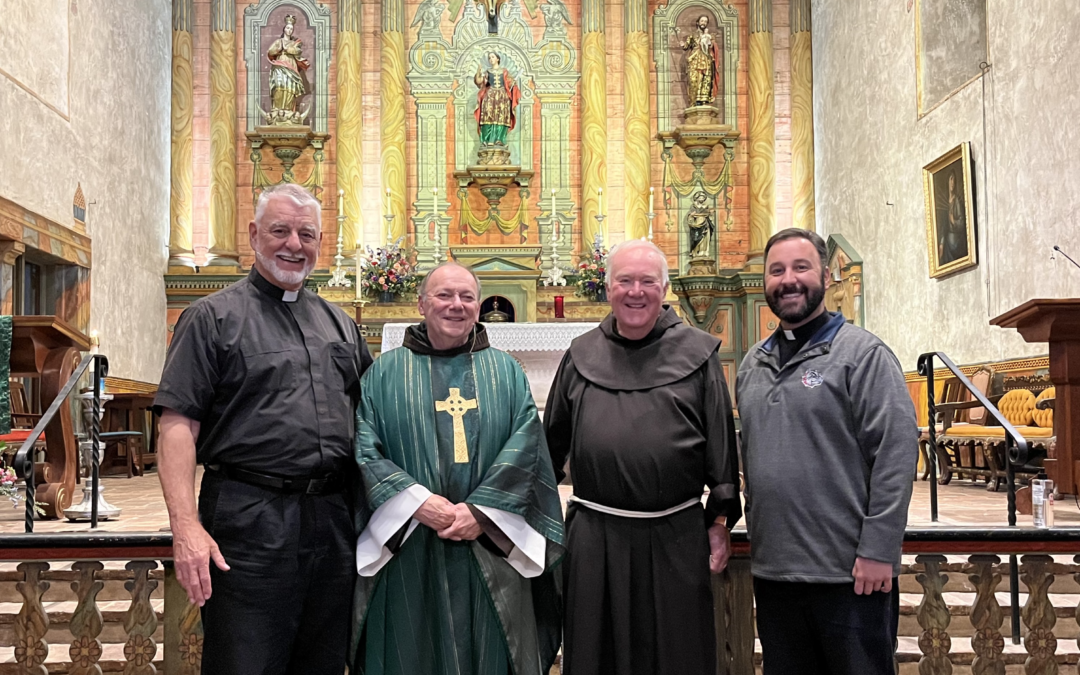
Nov 1, 2024 | News
Last month I wrote of my “mini-alumni-reunion” with Fr. Larry Lynn, class of 2015, in Coquitlam, as I made the trip north to Vancouver, B.C. in Canada from my retreat house in Oxnard, CA. There in beautiful British Columbia, Fr. Larry pastors the Catholic parish: Our Lady of Lourdes. Our time was a wonderful fraternal bonding. But there was more. The unexpected fruit of our reunion was an important “alumni collaboration” that brought an urgent message to our faithful immersed in a culture that has forgotten God and contends with the truth.
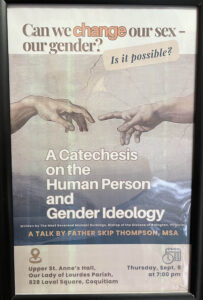 Here’s the “little blurb” I promised last time. Our collaboration delivered a “Catechesis on the Human Person and Gender Ideology,” — offered at Our Lady of Loudes on Sept. 5, 2024 — with the definitive Truth about who we are as men and women made in the image of God, (See Genesis 1:27). And we clarified the sexual dysphoria and deceits of Gender Ideology, which is one of the symptoms of atheism saturating our post-modern, post-Christian west. Recall the simple observation of Gaudium et Spes, 36, “When the Creator is forgotten, the creature becomes unintelligible.” Unintelligible is an apt description of Gender Ideology.
Here’s the “little blurb” I promised last time. Our collaboration delivered a “Catechesis on the Human Person and Gender Ideology,” — offered at Our Lady of Loudes on Sept. 5, 2024 — with the definitive Truth about who we are as men and women made in the image of God, (See Genesis 1:27). And we clarified the sexual dysphoria and deceits of Gender Ideology, which is one of the symptoms of atheism saturating our post-modern, post-Christian west. Recall the simple observation of Gaudium et Spes, 36, “When the Creator is forgotten, the creature becomes unintelligible.” Unintelligible is an apt description of Gender Ideology.
Before our offering, the chancery of the Archdiocese of Vancouver was consulted and approved our delivery of the conference. It is noteworthy that our brief promotion of this conference nonetheless produced more Catholics in attendance than was anticipated! People are hungry for the truth — and we presented vital Church teachings to counter the current cultural insanity. They want us back. That says is it all. Be not afraid.
Last month, I hosted another “mini-alumni-reunion,” this time at my retreat house in Oxnard, CA with Fr. Andy Cravahlo, Class of 2012 and a member of the “Fathers of Mercy.” Fr. Andy drove from his General House in Bowling Green, Kentucky — via Napa, CA — to Oxnard, (2,800 miles), rolled up, put it in neutral and stayed for awhile. I left the light on for him.

Fr. Andy Cravahlo, right — and Fr Skip. In front of the old Mission San Buenaventura in Ventura, California.
As with Fr. Larry up north, Fr. Andy and I enjoyed a full week of catch-up. Father enjoyed our ministries in the retreat house — and we took an easy and inspiring tour of the local, original Spanish missions, founded by the recently canonized (2015) Saint Junipero Serra, who “founded”
Fr. Andy Cravahlo, right — and Fr Skip. In front of the old Mission San Buenaventura in Ventura, California, 12 miles from the house. California. Indeed, most cities took their name from the original mission.
However, though regarded as our state’s founder, St. Junipero Serra is now a lightning rod of controversy, no thanks to the secular “historical revisionists” who attack the Catholic Church, Christianity in general, all our social institutions and the family. Did I miss any?
As a result, many of St. Junipero’s statues were vandalized and torn down during the summer of 2020 in the U.S. by various Marxist organizations that
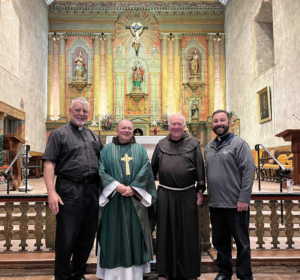
Fr. Skip, left, with Fr. Jack Clark Robinson, Fr. Larry Gosselin and Fr. Andy inside the old Mission Santa Barbara in Santa Barbara, CA
Fr. Skip, left, with Fr. Jack Clark Robinson, Fr. Larry Gosselin and Fr. Andy inside the old Mission Santa Barbara in Santa Barbara, CA fomented riots, looting, fires, assaults and even murder under the flag of “social justice.” As Fr. Andy and I spoke over several days, it became clear that he and Fr. Larry and I, shared important things in common: solid formation in the truth of Church teachings and hence true perspectives to “judge, not by appearances, but judge rightly.” (John 7:24).
Our faithful and orthodox formation at Holy Apostles College and Seminary gave us “right thinking” minds, able to critique our culture’s ideological errors and offer people the truth: about God, mankind, the very good news of Christ’s salvation and how we can journey successfully over the troubled waters of our times.
We asked ourselves, “how can we Alumni continue to assist one another,” as priest-classmates in common purpose of ministry to the faithful and to the world at large?
Our thought was to use our Alma Mater, Holy Apostles College and Seminary, as a clearinghouse of information by offering a “digital forum.” By it, HACS alumni can offer stories, ideas, and insights — to “cross-pollinate” each others’ hearts and minds — with the grace gleaned from respective ministries — for the good of all. It seemed a fine idea to our minds, so we offer it to all readers to consider.
What say you all?
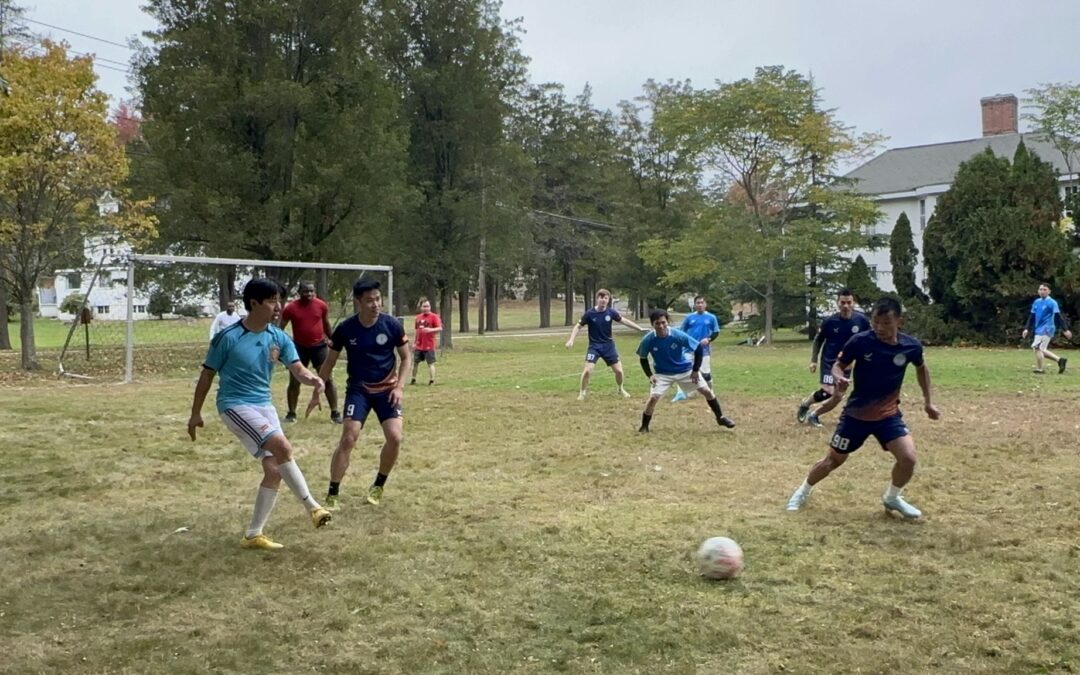
Nov 1, 2024 | News
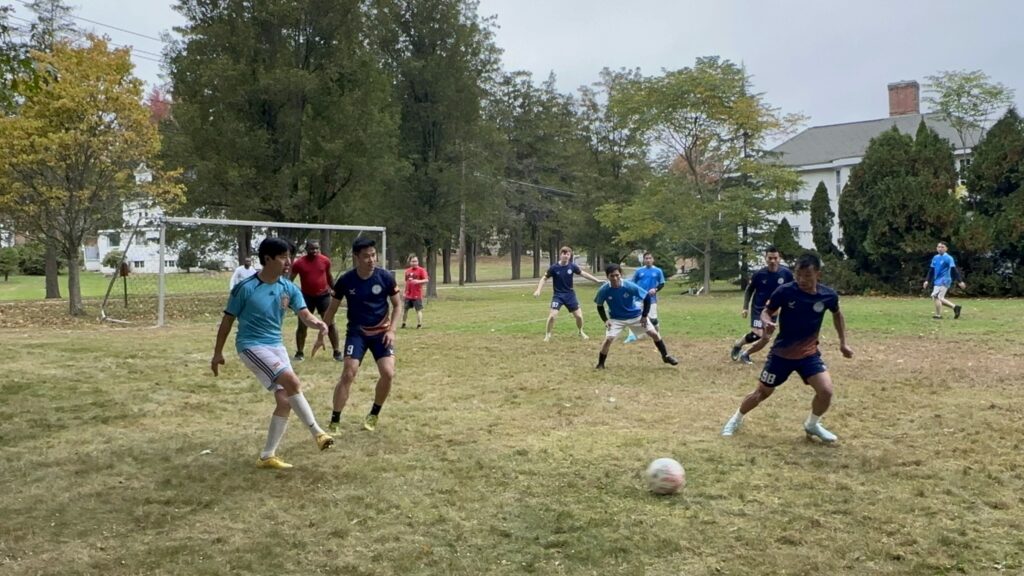
On Monday, October 14, 2024, Holy Apostles College & Seminary had the pleasure of hosting a friendly soccer match against Saint John Seminary (Boston) at the HACS soccer field. Held on the Columbus Day holiday, the game provided a wonderful opportunity to foster friendship and build fraternity among seminarians from both Seminary.
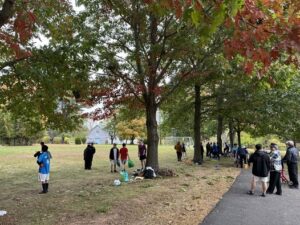 This event served as a moment for everyone to come together in support and encouragement of one another on their vocational journeys. The enthusiasm was palpable as priests, sisters, and seminarians cheered on the teams, creating a lively and memorable atmosphere for all involved. We are grateful for the chance to strengthen our bonds and celebrate our shared mission through sports.
This event served as a moment for everyone to come together in support and encouragement of one another on their vocational journeys. The enthusiasm was palpable as priests, sisters, and seminarians cheered on the teams, creating a lively and memorable atmosphere for all involved. We are grateful for the chance to strengthen our bonds and celebrate our shared mission through sports.
Article and photos by Seminarian Joseph Huan Tran

Nov 1, 2024 | News

This month, Holy Apostles College & Seminary seminarians, religious sisters, faculty, and students enjoyed a fantastic hike at Hubbard Park in Meriden, CT. The fall scenery of the Northeast was truly breathtaking, as the once-green trees had transformed into stunning shades of yellow, orange, and red, painting a vivid picture along the paths. Surrounded by this beautiful landscape under a clear blue sky and the crisp autumn air, they experienced a peaceful and refreshing sense of renewal.
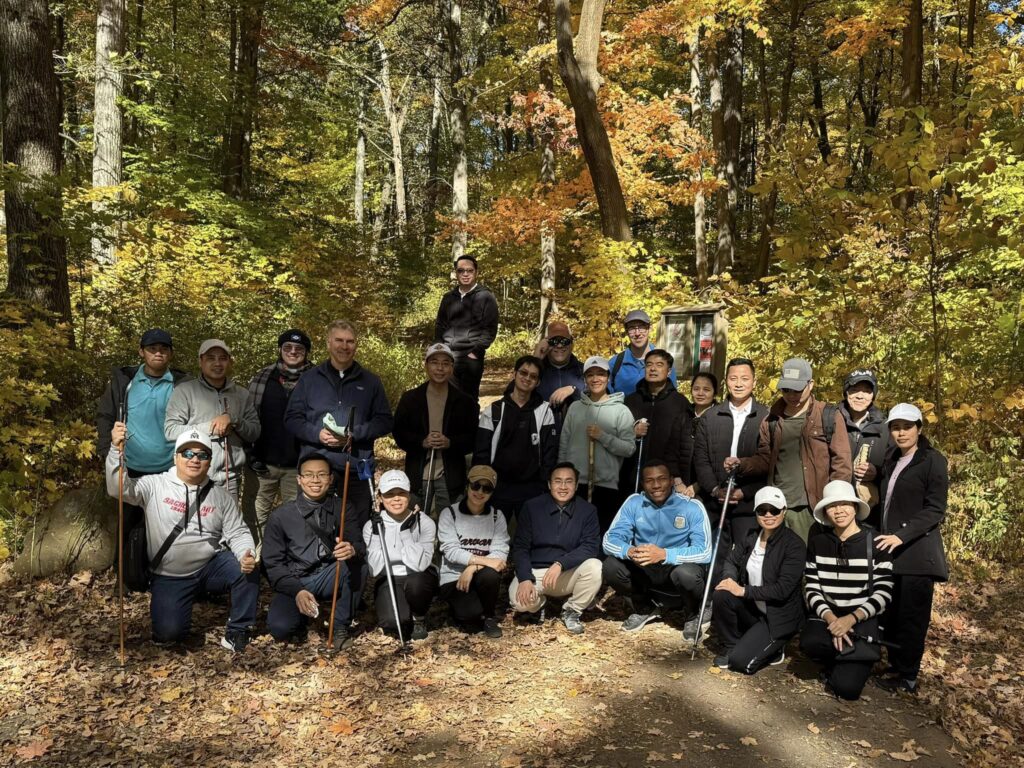 Hiking is not just about physical exercise; it holds a deeper meaning for our community. This outing allowed them to step away from their daily stresses, immerse themselves in nature, and, more importantly, strengthen their bonds as brothers and sisters. The laughter they shared, the stories exchanged along the way, and the simple joy of overcoming challenging parts of the trail together created unforgettable memories.
Hiking is not just about physical exercise; it holds a deeper meaning for our community. This outing allowed them to step away from their daily stresses, immerse themselves in nature, and, more importantly, strengthen their bonds as brothers and sisters. The laughter they shared, the stories exchanged along the way, and the simple joy of overcoming challenging parts of the trail together created unforgettable memories.
This experience not only allowed them to connect with the beauty of nature but also fostered a spirit of unity and support among our community. They returned to campus with not just a sense of accomplishment from the hike, but also with deeper friendships and a renewed appreciation for our community at Holy Apostles College & Seminary.
Article and photos by Seminarian Joseph Huan Tran








 Here’s the “little blurb” I promised last time. Our collaboration delivered a “Catechesis on the Human Person and Gender Ideology,” — offered at Our Lady of Loudes on Sept. 5, 2024 — with the definitive Truth about who we are as men and women made in the image of God, (See Genesis 1:27). And we clarified the sexual dysphoria and deceits of Gender Ideology, which is one of the symptoms of atheism saturating our post-modern, post-Christian west. Recall the simple observation of Gaudium et Spes, 36, “When the Creator is forgotten, the creature becomes unintelligible.” Unintelligible is an apt description of Gender Ideology.
Here’s the “little blurb” I promised last time. Our collaboration delivered a “Catechesis on the Human Person and Gender Ideology,” — offered at Our Lady of Loudes on Sept. 5, 2024 — with the definitive Truth about who we are as men and women made in the image of God, (See Genesis 1:27). And we clarified the sexual dysphoria and deceits of Gender Ideology, which is one of the symptoms of atheism saturating our post-modern, post-Christian west. Recall the simple observation of Gaudium et Spes, 36, “When the Creator is forgotten, the creature becomes unintelligible.” Unintelligible is an apt description of Gender Ideology.



 This event served as a moment for everyone to come together in support and encouragement of one another on their vocational journeys. The enthusiasm was palpable as priests, sisters, and seminarians cheered on the teams, creating a lively and memorable atmosphere for all involved. We are grateful for the chance to strengthen our bonds and celebrate our shared mission through sports.
This event served as a moment for everyone to come together in support and encouragement of one another on their vocational journeys. The enthusiasm was palpable as priests, sisters, and seminarians cheered on the teams, creating a lively and memorable atmosphere for all involved. We are grateful for the chance to strengthen our bonds and celebrate our shared mission through sports.

 Hiking is not just about physical exercise; it holds a deeper meaning for our community. This outing allowed them to step away from their daily stresses, immerse themselves in nature, and, more importantly, strengthen their bonds as brothers and sisters. The laughter they shared, the stories exchanged along the way, and the simple joy of overcoming challenging parts of the trail together created unforgettable memories.
Hiking is not just about physical exercise; it holds a deeper meaning for our community. This outing allowed them to step away from their daily stresses, immerse themselves in nature, and, more importantly, strengthen their bonds as brothers and sisters. The laughter they shared, the stories exchanged along the way, and the simple joy of overcoming challenging parts of the trail together created unforgettable memories.